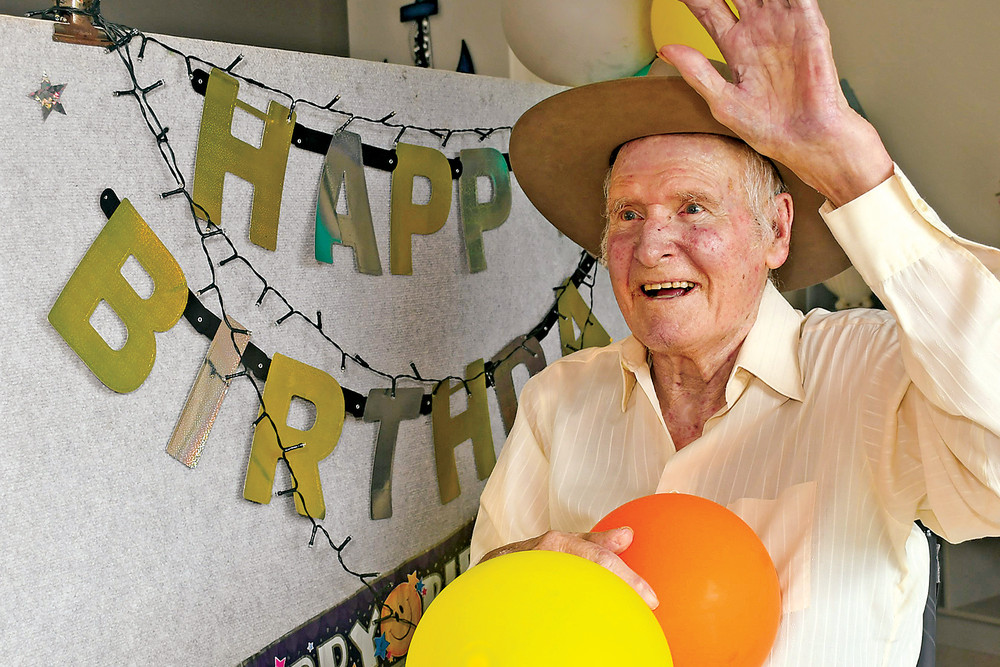General News
7 May, 2023
Celebrating a century of George
A RESIDENT at Carinya Home for the Aged is withstanding the test of time, celebrating his 100th birthday this month.

George Hopgood was born in Deloraine, Tasmania on 17 May 1923 and spent his early years living on an apple orchard with his parents and two brothers.
He was 12 years old when he left school and began work where he learned many skills that helped him through his life.
George always loved drawing, especially cars, trains, and planes but his brothers teased him and made fun of his drawings.
On 6 February 1942 at the age of 18, George enlisted in the army at Belmont in Victoria and commenced military training and worked on trucks and tanks.
George was one of the many Australian troops who participated in the fierce battle for the port of Finschhafen from 22 September until 28 October 1943, marking the beginning of the Huon Peninsula campaign to evict the Japanese from that territory.
Once Finschafen was secured, George was posted to Nadzab near Lao where he was trained in anti-malarial control measures.
It was during this time that Georges artistic skills were put to good use helping to inform troops about the dangers of malaria – a disease spread through mosquito bites.
George was employed by both the Australian and American army to produce drawings of mosquitoes for anti-malaria posters.
He said he wasn’t paid with money for his art but got the same food as the officers, and that it was the first time he ever drank a coke, which he believes was the most magical moment.
From Nadzab George was sent to the large, allied airbase on the island of Morotai which was then in the Dutch East Indies, which is now Indonesia.
Whilst having dangerous encounters there with surrendering Japanese soldiers in the jungle he was offered a ride as a navigator/passenger on a reconnaissance operation in a twin-engine Bristol Beaufighter bomber.
During that flight the pilot demonstrated all the capabilities of that aircraft and in that moment, George promised himself that he would become a pilot once the war ended.
Now back in Australia in 1947 at Bankstown Airport, George commenced his pilot training. He began in a De Haviland Tiger Moth.
George said the pilots sat in the rear seat of those planes be-cause that’s where the rudimentary fuel gauge was located. It consisted of a cylindrical glass instrument with measurements on one side. Inside the glass there was a float attached to a thin dowel.
The float showed how much fuel the plane still carried, and as the float got lower.
“You would always hope you were close to home, so that you had enough fuel for a power approach to the air strip,” he said.
George progressed to flying an Aster which was a single wing aircraft with the same motor as the Tiger Moth. Following being awarded with both his solo and Commercial pilots licence George went on to become a qualified flight instructor a job he held until he retired.
During his long working life George had many memorable encounters with clients, one of these was the launch of the Aus-tralian designed and built Victa Airtourer.
In 1970, George met his first wife Melva and gained his step-son Neville and later welcomed another son Geoffrey.
Travelling is something George enjoys the most and has fond memories of his time in America and fishing in Darwin.
He is also life member of the Ravenshoe Golf Club, a very talented harmonica player and often accompanies the Carinya Band on music days.
While George has been liv-ing at Carinya he has kept up flying, but this time it is with radio-controlled model aircraft with the MASCOT NQ.
During this later chapter of George’s life, he has by no means been idle, often attending the gym at Carinya’s new Well-ness Centre and attends many of the activities that are on offer when he feels up to it.
George takes great satisfaction in being able to recount his stories of his extraordinary life


